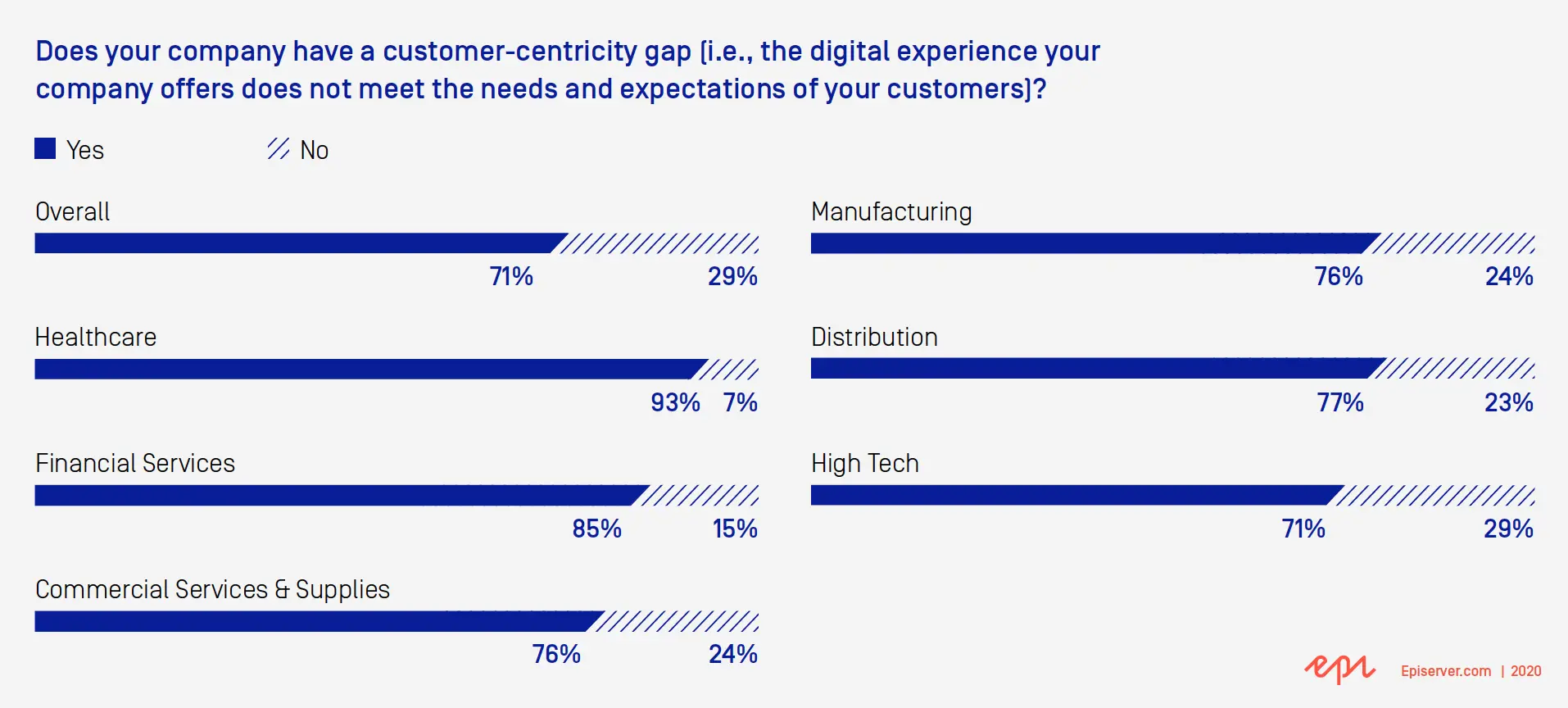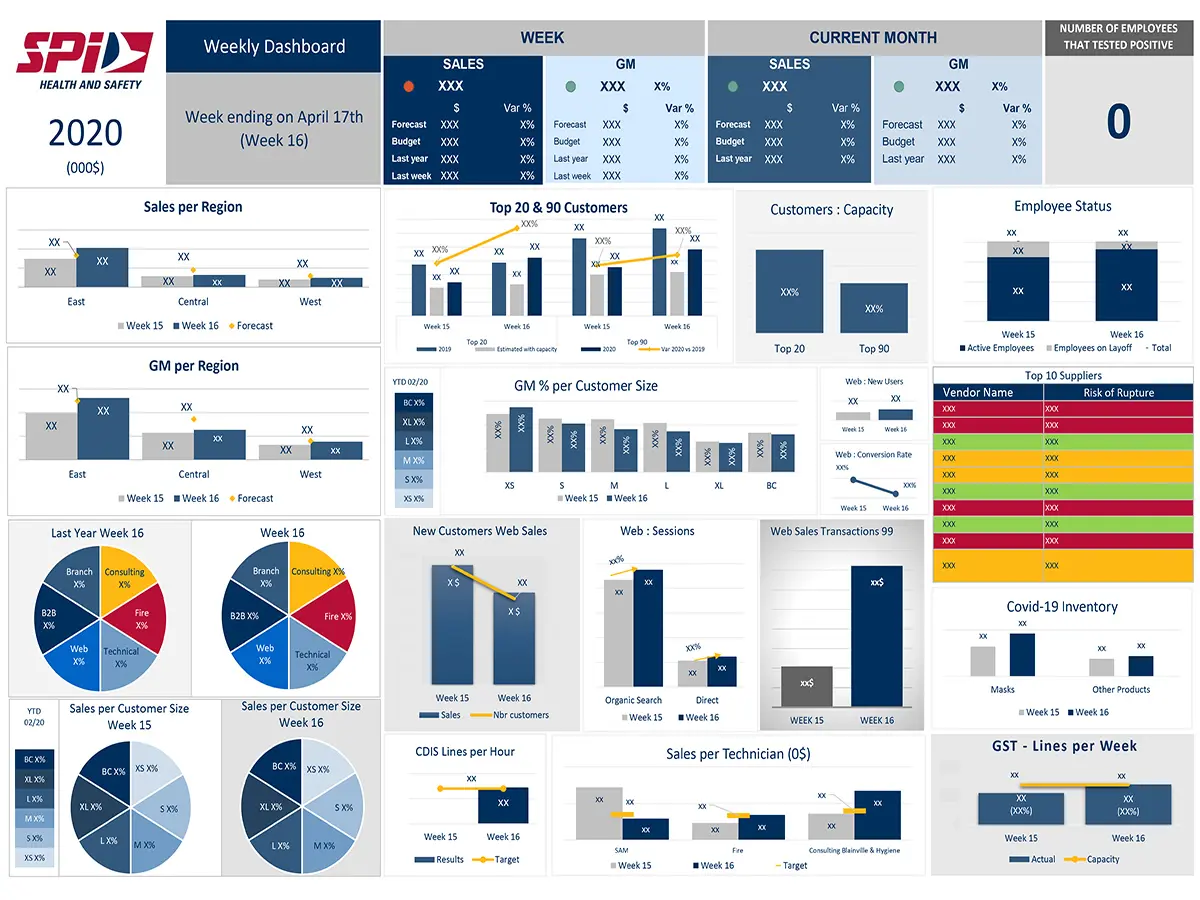Distributors talk digital strategy and dive into what's next
How distributors are tackling concepts like customer centricity, selling direct, budget allocation, digital strategy and more as they emerge out of the COVID-19 fog and plan for the second half of 2020 and beyond.

Morgan Short

The supply chain as we know it has changed. Across industries, distributors who invested in their digital infrastructure pivoted quickly with creative ways to serve their customers - some even accelerated their digital transformation projects in months, not years. While others dealing with organizational red tape or tripping over legacy systems have struggled to adapt to this digital-first world.
Recently, Episerver and our partner, Absolunet sat down with leaders from top distributors including SPI Health and Safety (SPI), Macpek and Refrigerative Supply (RSL) to learn how their companies shifted due to social distancing, what they’re doing differently today and plan to do differently tomorrow in this digital-first world.
To set the stage, Nate Barad, product marketer and strategist at Episerver shared some findings from Episerver’s 2020 B2B Digital Experience Report which surveyed 600 B2B decision-makers about digital experience tactics and technology. Charles Desjardins, executive vice president and partner at Absolunet unpacked each area of focus with the panelists. You can watch the full panel here, otherwise here's a synopsis of what we learned:
Why it’s important for distributors to close the customer-centricity gap
According to Episerver’s research, 71 percent of B2B leaders across industries agree their company has a customer-centricity gap. Essentially, the digital experience they are offering is not meeting the expectations of their customers. Distribution is worse coming in at 77 percent.

As a result of the COVID-19 crisis, companies across industries saw a shift in customer expectations. Distributors had to find ways to better align to changing customer expectations and work to close the customer-centricity gap.
SPI Health and Safety, a Canadian leader in occupational health and safety products, training and services, reacted quickly to better manage their company in a time of crisis. SPI wanted clear visibility into key performance indicators like sales, gross margin, number of employees with the virus, top customers, critical inventory supply and more. SPI worked closely with different departments in the company to deliver a simple dashboard reviewed weekly by key executives in the company. The dashboard was instrumental in monitoring the evolution of the pandemic’s impact on SPI’s employees, customers, processes and overall business.

Like clockwork, Refrigerative Supply, a leading HVAC and refrigeration distributor, launched their ecommerce offering shortly before peak pandemic times. Delivering their product catalog online has allowed their customers to self-serve and has been a central resource for employees working from home or in the branch.
In terms of changing customer behavior, Macpek, a heavy-duty vehicle parts and car wheels distributor, noticed a spike in online traffic. More clients have been asking for usernames, passwords and access to the website. In addition, they’ve seen less in-person traffic. Overall, the flip in traffic from in-person to digital channels has helped Macpek control the health and safety of its employees and customers.
Whether distributors had digital frameworks in place or had to pivot quickly to get digital efforts launched, it’s clear that the pandemic was the catalyst that accelerated digital transformation. Companies are continuing to find ways to innovate, make data-driven decisions and serve their customers digitally. In turn, they are focusing efforts on closing the customer-centricity gap.
Selling direct is a BIG opportunity in distribution going forward
According to Episerver’s research, 41 percent of distributors report selling direct as the most significant opportunity for their business. As distributors face the impacts of the pandemic on business and consider growth tactics for the future, many are considering going direct – if not doing so already.
Though SPI wouldn’t tout selling direct as their biggest opportunity, it certainly plays a role in their ecommerce strategy. Instead, their biggest opportunity is to be able to sell their products, services and training across any channel. They are working to build out a multichannel strategy so they can meet customers’ expectations whether they are buying online or offline. SPI predicts the website will help them better serve their customers and increase market share.
Though Macpek is a heavy duty truck distributor, the company is looking to expand to selling to individual owner-operators. In fact, individual owner-operators are the biggest opportunity in their market. Macpek leads with a customer-first approach, at the individual level. Leveraging their ecommerce solution, Macpek aims to attract new markets. The goal is to enable owner-operators to purchase products on their own time and have them delivered wherever they see fit. Macpek predicts that taking this approach will be a huge opportunity for increasing sales in their business.
The trend toward selling direct in distribution means the role of the salesperson is inevitably changing as well.
RSL, for example, sells solely through their trade partners, however sales roles are quickly evolving. As sales reps can no longer visit customers, being able to connect with them digitally is crucial. This is true across many distribution businesses. Salespeople must be armed with digital technology and analytics in order to put their best foot forward and serve their customers. RSL sales representatives have always been committed to helping customers select the best product for them, the website only improves their ability to serve their customers.
In order to best enable your sales team, you have to gain their buy-in for B2B ecommerce early and often.
At SPI, for example, they needed buy-in across their company and recognized the importance of onboarding their sales team. The sales team was looped into the digital transformation early on and SPI leaders worked to communicate the value ecommerce could bring to the customer journey.
Distributors are filling the event-marketing gap with digital tactics
Budget is an interesting topic, especially in a time of crisis. When asked what digital investments decision-makers were making for the year, commerce and personalization were noted as top investments in Episerver’s survey. As budget has been removed from in-person events and trade shows, distributors have sought out new ways to generate leads with a reliance on digital efforts.
At RSL, residential dealers each have a set budget for marketing efforts. Traditionally, many of them would spend their budget on radio and local television spots. However, a majority are now moving their budgets online.
SPI has a similar story. Traditionally, SPI allocated budget to in-person events and tradeshows. Luckily, they were geared up to attend and host virtual events. With a new in-office studio and tech-savvy employees, SPI has developed a strong webinar strategy. It was easy to shift their traditional events to a virtual world. They’ve upped their game when it comes to online trainings. Registration and participation increased and has given SPI many opportunities that might not have existed previously. SPI seamlessly adapted their content and responded to customer expectations online.
For the last four years, Macpek has been investing in digital very heavily. Previously, the budget was shared across the entire company. When many elements of the budget were paused, allocation for digital was not. While budget allocation for things like physical stores was put on hold, digital became non-negotiable.
Many large enterprises are experiencing similar trends. While budgets are frozen or put on hold, investment in digital is being prioritized.
Leveraging digital improves customer relationships in distribution
In B2B, where many companies are working with partners to provide sound solutions to the customer, often relationships can be tested. According to Episerver’s research, more than half of B2B leaders (54 percent) suggest their customer relationships are strained or in development, perhaps due to partners.
Distributors know the challenges that come with attracting new customers. Losing customers can be even more costly to overall business. However, the appropriate digital strategy can keep customers engaged and build loyal fans.
Fortunately Macpek’s ecommerce website was built by people who have deep knowledge about their products. Employees who work on building the content for the website have actually worked the counter for 10 to 15 years. Macpek’s website instills confidence in their customers. They no longer need an in-person expert to make purchases. They are able to make the right purchases online with ease. In a way, the website is a Macpek employee that works for customers 24/7.
RSL credits their ecommerce site with helping to build customer loyalty. There are always a range of customers who still want the face-to-face interaction (some even despite COVID-19) so they need to ensure they are taking care of both customers who are reliant on digital and customers who prefer traditional ways of interacting. A post-COVID-19 world means more digital touchpoints and an increased appetite for online tools.
After implementing ecommerce and monitoring their digital evolution, SPI has increased their digital net promoter score by 32 points. Going forward, they are prioritizing building out rich product information, improving the speed of the website and delivering a better overall experience that is personalized for each user.
Addressing complex pricing and quoting challenges online
Personalization is a perfect segway into the next topic. Roughly 50 percent of organizations responded to Episerver’s survey that they provide a mature digital commerce experience for customers to purchase at negotiated prices.
A B2B ecommerce solution built specifically for distributors should enable them to accommodate customer contracts and agreed upon pricing, both online or offline. B2B Commerce Cloud by Insite enables SPI, RSL and Macpek to seamlessly provide customer-specific pricing.
PunchOut technology allows SPI’s customers to access the ecommerce website, checkout and filter the order through their own system and approval workflows. This enables them to serve larger customers with more complex challenges.
Episerver B2B Commerce Cloud by Insite provides request for quote functionality, out-of-the-box. Refrigerative Supply is marching toward incorporating online quoting down the line. Currently prices are negotiated in person, inputted into the ERP system and integrated into ecommerce. Macpek is also looking to build out more pricing and quoting options online.
Online sales will take an even bigger chunk of the pie moving forward
According to Episerver’s research, about two-thirds of manufacturers and distributors are securing between 40 and 80 percent of their revenue online. Given the pandemic, online channels seem to be accelerating before our eyes.
At Macpek, 34 percent of sales are currently generated online. The executive team is completely committed to investing in improving their digital channels. Similar executive-level buy-in for digital is true for both SPI and RSL. Looking ahead, all three companies expect online sales to grow.
The future is AI
In Episerver’s report, 82 percent of B2B leaders stated that AI will make them better at their job. AI is a very broad topic but appears in ecommerce in a variety of ways. AI takes the form of advanced merchandizing (posing the right product in front of the right customer), auto-content scripting, intelligent search and more. Many distributors face the challenge of enriching the product information of thousands of SKUs. New and emerging technologies can assist with this daunting task. There are many areas where AI can improve your processes, especially where ecommerce is concerned.
SPI, RSL and Macpek are all aware of the prominence AI is likely to have in the future. Currently, all three companies are working on building a strong ecommerce foundation, an teams in place to help implement new technologies like AI and IoT. RSL, in particular is focusing on building a strong data set so when the time comes for AI, they are ready to handle the intricacies that come with it.
At the end of the day, many B2B companies are slowing down to speed up. They’re pausing to reflect on internal processes, employee efficiency and customer satisfaction. Overall, distributors are committed to pivoting quickly, delivering at high-speed and improving the B2B digital experience as they pave the path onward.
